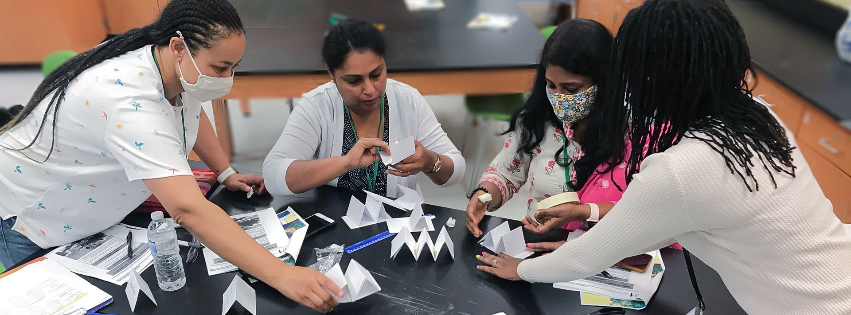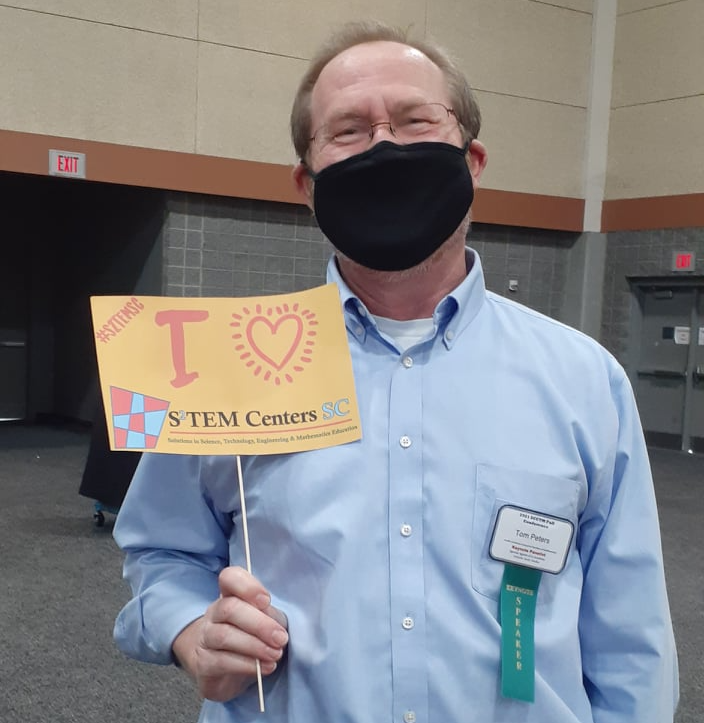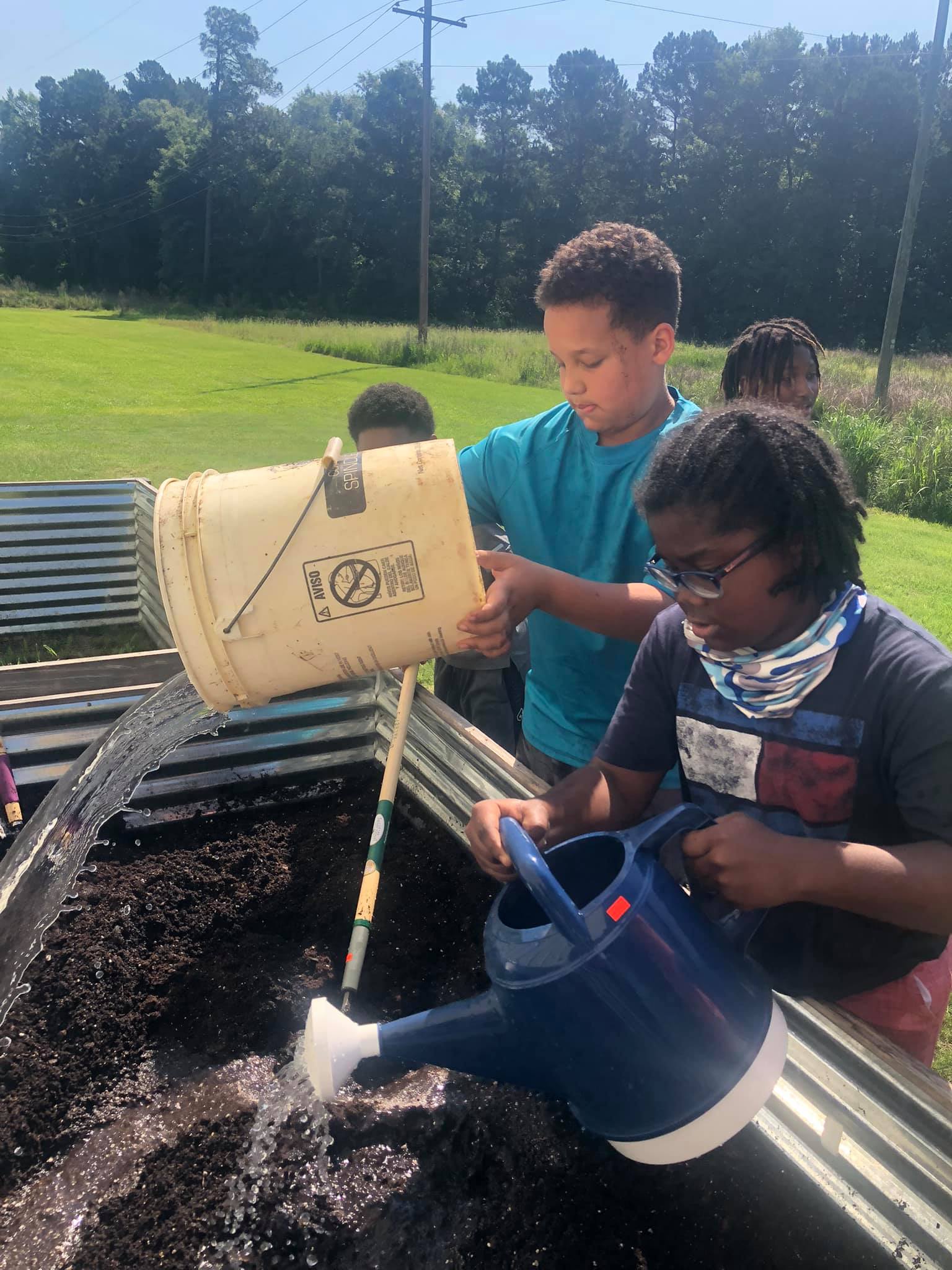Q: Tell us about the South Carolina Grand Challenges in STEM: What are they, how did they come about, how have they shaped your work and how is SCCMS doing in meeting these challenges?
A: In 2017, we were awarded a
STEMx/Battelle Challenge Grant. With additional support from Boeing SC, Comporium and Fluor, we hosted a Grand Challenges in SC STEM Summit. Dialogue was centered on research conducted by
100Kin10, a national network committed to adding excellent STEM teachers to U.S. classrooms. The research identifying root causes and possible actions to address the critical shortage of STEM teachers was shared with thought leaders from across South Carolina who added to this knowledge base and critically examined the state of STEM education in South Carolina.
From this dialogue, we identified
five key challenges associated with overarching themes of valuing STEM teachers and STEM teaching.
Q: What/who are your other notable partners and how do they help SCCMS advance STEM education in your state?
A: Every partner we have is notable in its own way. Our “Founding Partners,” those whose foresight and financial support created SCCMS as we know it today, are BMW Manufacturing Co., Michelin North America, Duke Energy and DuPont.
Of course, I must recognize Clemson University. SCCMS is not a stand-alone 501(c)(3). Clemson’s College of Engineering, Computing and Applied Sciences and the Clemson University Foundation support our infrastructure and give us the ability to accept grants and gifts.
Other organizations, such as Lander University and Spartanburg School District 7, support our regional “bricks and mortar” needs. And hundreds of individuals volunteer their time and talents to our community STEAM festivals and other coalition initiatives.
Q: Your organization manages other STEM-based groups. How does that work? Tell us about these groups – S2TEM Centers SC, DIG, STEMLinx – and the role you play in their work.
A: As I have mentioned, SCCMS is a true coalition. We are greater than the sum of our parts. And our parts are pretty great, too!
S2TEM Centers SC is the living, functioning, current generation of the statewide network established by the SC Statewide Systemic Initiative. This action network is self-managed, with mission guidance and financial oversight from SCCMS. Its connection to SCCMS was codified by proviso in 2011. It is nearly impossible to determine where SCCMS ends and S2TEM Centers SC begins. Two sides of the same coin as structured. Action and advocacy melded together.
Our partnerships with
DIG, the
EE Just Foundation and
Million Women Mentors SC are a bit less obtuse. DIG and EE Just are nonprofits with their own boards of directors. We provide technical assistance in the form of a shared staff member with DIG and advocate for the programs of both. Million Women Mentors SC does not have nonprofit status. We manage their financial resources and contribute staff time to their efforts.
These three organizations do an incredible job reaching out to underserved populations including those in regions of our state where a personal connection is a key to credibility.
Q: What about your own programs, which include the upcoming STEM Education Month (March 14-April 11): Describe these programs and how they advance STEM education in your state.
A:
STEM Education Month began as STEM Education Day at the State Capitol in 2018 and has continued to morph and grow. It was the brainchild of
Rep. Sylleste Davis, who called on us to help create a platform to recognize student success in robotics competitions.
During STEM Education Month, which always kicks off on Pi Day, we now recognize dozens of STEM education focused programs, organizations and individuals including our STEM Educator of the Year. STEM Education Day at the State Capitol is scheduled for March 17.
Our other programs include the
iMAGINE STEAM Festivals, which are community events to promote interest in STEAM learning and careers, and our social media presence. Along with our
STEMLinx wakelet, we are active on Facebook, Twitter and via an e-newsblast.
During the 2020/21 fiscal year we recorded nearly 370,000 social media engagements.
Q: How is SCCMS helping to build the workforce of tomorrow?
A: The operative word for SCCMS when it comes to workforce is “opportunity.” As a lead organization, our efforts to increase opportunity are twofold. First and foremost, we support and improve STEM teaching through the work of our S2TEM Centers SC education specialists. As an example, we are providing curriculum and content professional development to elementary teachers focused on student learning in science and engineering through a
Smithsonian Science for North and South Carolina Classrooms partnership with the Smithsonian Science Education Center.
Second, we engage communities with their local STEM workplaces, as previously described, through the community-based iMAGINE STEAM Festivals.
As a partner organization, we add PK-12 STEM expertise to the efforts of many workforce focused organizations including the Department of Commerce, the
Clemson University Center for Workforce Development and the SC Council on Competitiveness, the latter of which helps to promote STEM teaching as a STEM career by identifying and honoring a
STEM Educator of the Year.
Q: What is SCCMS best known for? What is the biggest accomplishment of SCCMS in the past year or so?
A: I think, first and foremost, we have a reputation for versatility coupled with quality. There is not much in STEM that we have not done and done well. We have led instructional coaching initiatives, supported teachers as they added disciplinary literacy and computational thinking strategies to their repertoire, assisted schools seeking STEM certification, introduced preservice teachers to STEM concepts, piloted STEM activities in afterschool settings and much more. All, while maintaining a client satisfaction rating averaging 94% during the past four fiscal years.
I’ve heard that we are also known in some circles for our grit and determination. As you might imagine, we’ve been on the brink of extinction a few times over nearly 30 years, and still, here we are.
Q: What is on the drawing board for SCCMS?
A: I think it is time to be new again. As we emerge from pandemic times, we have an opportunity to rethink and reinvigorate our alignment with government agencies. Our crazy-quilt structure, patched together through three decades of birth and rebirth, is beautiful in its own way. And it is neither simple to understand, or explain, or to be passed along to an inevitable next generation of leadership.
Q: Give us a fun fact about yourself that other STEMx members might want to know.
A: As I think back across the years, there are many stories that could be told involving a velvet Elvis, or pirates, or “the bad table” or even a Will Ferrell moment in Florence.
These stories are best told over a good beer. Cheers!







